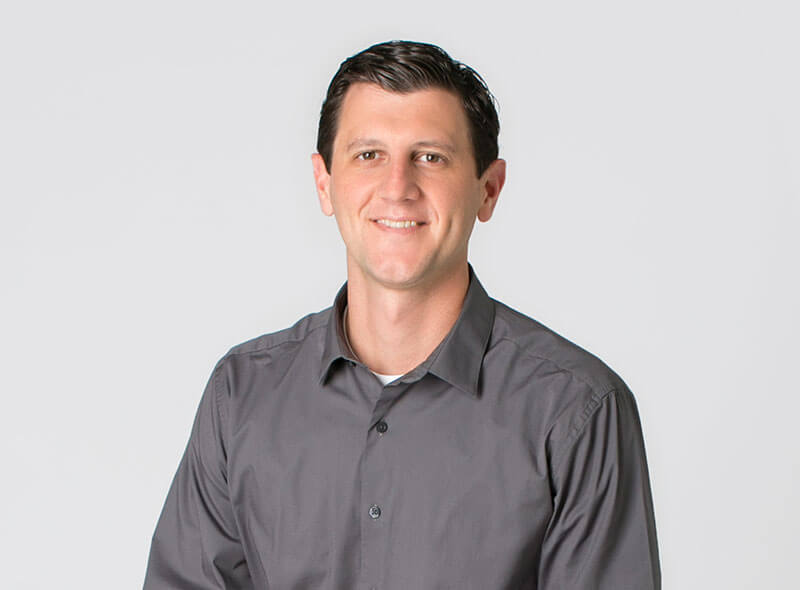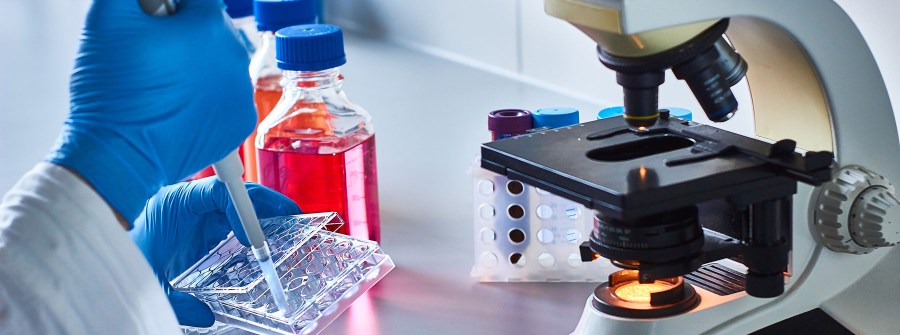The ultimate guide to
Orthobiologic Therapies
Understand how platelet-rich plasma injections and tissue and cell therapies may decrease pain and restore function for orthopedic injuries, and potentially help avoid major surgery.

This guide discusses ...
Orthobiologics may reduce pain and restore function
When you are an active individual, the last thing you want to deal with is joint or muscle pain. That’s why many of you are looking for ways to remain active, prolong your joint function or avoid major surgery. OrthoIndy physicians not only offer joint preservation surgery but equally focus on avoiding surgery whenever possible by providing minimally invasive treatment options for our patients.
OrthoIndy doctors have been at the forefront of treatment with orthobiologics for orthopedic injuries and conditions such as arthritic joints, broken bones, injured muscles, tendons or ligaments. Orthobiologics are natural tissue-derived products that orthopedic surgeons use that may help decrease pain and restore function and potentially avoid or delay major surgery, like joint replacement surgery. The orthobiologic substances consist of cells, proteins, glycoproteins and complex carbohydrates that are naturally found in the body.
The goal of the orthobiologics program at OrthoIndy is to provide cutting-edge treatment options with a sound scientific foundation. When non-operative options have failed, our doctors may prescribe platelet-rich plasma (PRP) injections or tissue and cell therapies.
OrthoIndy’s Ultimate Guide to Orthobiologics will help you better understand how platelet-rich plasma injections and tissue and cell therapies may help reduce pain, restore function and potentially help delay or avoid major surgery.
1 What are orthobiologic therapies?
Orthobiologics are natural tissue-derived products that orthopedic surgeons use that may help injuries heal quicker and may delay major surgery. These injuries and conditions may include arthritic joints, broken bones or injured muscles, tendons or ligaments.
The orthobiologic substances consist of cells, proteins, glycoproteins and complex carbohydrates that are naturally found in the body. When orthobiologics are used, they may enhance the healing process by decreasing inflammation, pain and stiffness and improving the patient’s ability to function.
READ MORE: UNDERSTANDING ORTHOBIOLOGICS IN ORTHOPEDIC TREATMENT
OrthoIndy OrthoBiologics Program vs. Stem Cell Clinics
You may have heard or seen advertisements about “stem cell” treatments. The term “stem cells” is not approved by the Food and Drug Administration (FDA). And you should be leery of medical practices that claim they do “stem cell” injections.
The main goal of orthobiologics is to decrease pain and improve function. If you are experiencing pain from arthritis, injections won’t make your body grow new cartilage (as implied by some centers), but they may decrease pain and improve your quality of life.
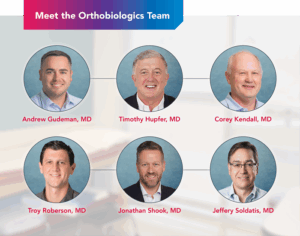
Meet the team of orthopedic specialists dedicated to the field of orthobiologics.
2 What are PRP injections and tissue therapies?
Our orthopedic doctors utilize platelet-rich plasma (PRP) injections and tissue therapies from fat, bone marrow and/or amniotic membrane suspension allograft to help decrease pain and keep you active.
What are platelet-rich plasma (PRP) injections?
PRP injections use your own plasma, platelets and modulating factors (which are inside the platelets) to promote a healthier joint environment. There are different kinds of PRP injections, some with low white blood cell count and some with high white blood cell count. Each is used for different applications. These injections have been shown to create a less inflammatory environment in the injured body part, which can result in less pain and improved function.
Blood is composed of a fluid component called plasma that can be separated from the small, solid components (red cells, white cells and platelets). PRP simply means the prepared plasma has more platelets per volume than the patient’s own whole blood. The concentration of platelets can be two to ten times greater (or richer) than the patient’s blood.
Platelets are one of the first biologic products to reach an injury. Their first function is to participate in sealing the injury with a clot. During the blood clot formation, they release over 1,500 biologically active proteins, including both growth factors and “signaling” factors (that recruit adult tissue-specific cells to aid in the repair process). These factors aid in initiating the healing response at a site of injury and when used as an injection can improve the balance of the inflamed joint.
Read Article: Can PRP injections decrease your knee pain?
What are tissue and cell therapies?
“Stem cell injections” are widely and improperly promoted. In the field of orthobiologics, the cells (previously termed mesenchymal stem cells), can be found in the bone marrow, muscle and adipose tissue (fat).
At OrthoIndy, we offer PRP injections and an alternative using adipose tissue called Lipogems®.
Should I have a PRP injection or tissue and cell therapy?
While both PRP injections and tissue and/or cell injections are non-surgical treatments used to potentially preserve the joint or restore function, they are not the same treatment. PRP injections, which are more common, are derived from the blood while tissue and cell injections are derived from bone marrow or adipose tissue (fat).
According to sports medicine physician, Dr. Jonathan Shook, the type of injection used is dependent on the type of injury. “PRP injections may be able to aid in initiating a body’s healing response, although they have no ability to regenerate tissue,” he said.
Depending on your injury or condition, your doctor may choose to use a specific type of injection. Or if you received a PRP injection and it was not successful, then another tissue and cell therapy may be an option.
Am I a candidate for orthobiologics?
How do you know if orthobiologic therapies are right for you? Answer the following questions to see if you are a candidate for PRP injections or tissue therapies.
- Do you have a tendon injury or arthritis (osteoarthritis)?
- Has anti-inflammatory medication failed to relieve your pain?
- Did bracing fail to work?
- Has physical therapy failed to help relieve pain and restore function?
- Have cortisone injections failed?
If you answered “yes” to all of the above, then orthobiologics may be right for you. Your OrthoIndy doctor will work with you to determine the best course of treatment for your specific injury.
 Sports medicine specialist, Dr. Chris Bales describes what to expect when receiving a platelet-rich plasma injection.
Sports medicine specialist, Dr. Chris Bales describes what to expect when receiving a platelet-rich plasma injection.
3 Do orthobiologic therapies work and what are the benefits?
Whether your orthopedic surgeon recommends a PRP, amniotic membrane suspension or a tissue injection, potential benefits include:
- The potential to delay or avoid major invasive surgery, such as joint replacement surgery.
- The recovery is faster than a major surgical procedure.
- Depending on which therapy is used, treatment may be performed in the office as an outpatient procedure.
- Orthobiologics are natural substances found within the body rather than drugs or chemicals.
How effective are the orthobiologic treatments?
This is a very exciting time for orthopedic medicine as we continue to find more options to potentially slow down arthritis symptoms without surgery. With orthobiologics we are beginning to understand how to stimulate the body to improve comfort and function. However, orthobiologic injections are not for everyone and may not be an option for you.
At OrthoIndy, we are using these treatments to stimulate your own body to improve comfort and function, but how your body responds to the treatments is, unfortunately unpredictable.
“There are a number of studies that show the effectiveness of PRP injections for treatment of osteoarthritis of the knee,” said Dr. Troy Roberson, OrthoIndy sports medicine specialist. “According to these studies (see below), PRP injections are effective in improving osteoarthritis symptoms.”
Dr. Roberson adds that studies are showing the effectiveness of tissue and cell injections. “Multiple studies over the past five years have shown good to excellent reduction of pain and improved function a year after the injection and in some cases up to two years with varying types of reparative call preparations.”
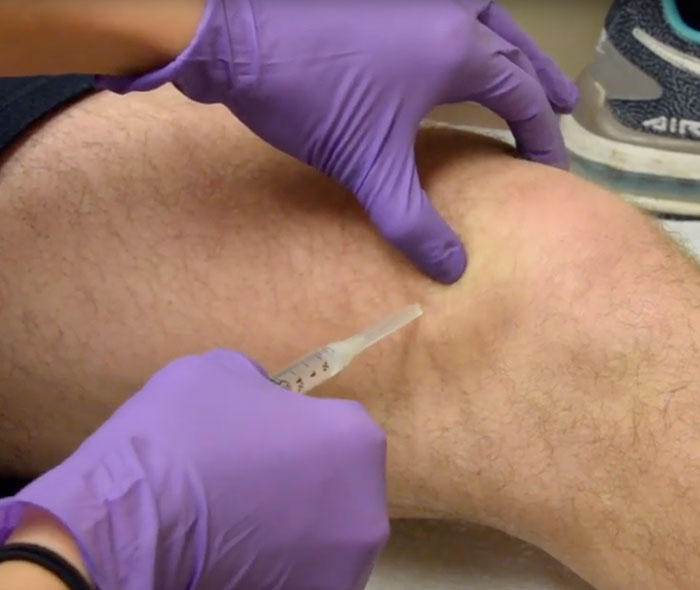
Tissue and Cell Therapies
Learn more about tissue and cell injections and how they may help relieve pain and restore function.
While participating in an OrthoBiologics panel discussion at the 2020 TOBI meeting, Dr. Farr agreed with the other panelists that the knee osteoarthritic patient most likely to respond has the following characteristics:
- Some joint space remaining (not “bone on bone”)
- Some degree of occasional swelling, which suggests a component of inflammation
- Low or moderate body weight
- The osteoarthritis involves the thigh/shin bone (femoral/tibial) portion of the knee as opposed to the kneecap (patellofemoral compartment)
Scientific Studies about the Effectiveness of Orthobiologics
For more information about the benefits of orthobiologics, please visit the following sites:
- PRP May Improve Clinical Outcomes of Knee OA Better than Hyaluronic Acid
- Efficacy of Intra-articular Platelet-Rich Plasma Injections in Knee Osteoarthritis
- Platelet-Rich Plasma Versus Hyaluronic Acid Injections for the Treatment of Knee Osteoarthritis
- Concentrated Bone Marrow Aspirate for the Treatment of Chondral Injuries and Osteoarthritis of the Knee
- Intra-articular Mesenchymal Stem Cells in Osteoarthritis of the Knee
- Intra-articular Injection of Mesenchymal Stem Cells for the Treatment of Osteoarthritis of the Knee: A 2-Year Follow-up Study
- A Randomized Controlled Single-Blind Study Demonstrating Superiority of Amniotic Suspension Allograft Injection Over Hyaluronic Acid and Saline Control for Modification of Knee Osteoarthritis Symptoms
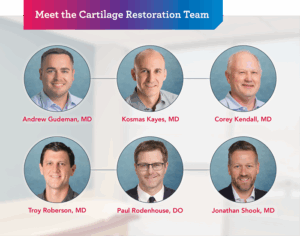
Meet the team of specialists dedicated to cartilage restoration.
4 What to expect after treatment?
One of the benefits of orthobiologics is recovery time. Unlike major surgery, the injection is in most cases done in the clinic and you can resume normal (but not increased) activities almost immediately.
Following your injection, you may experience some discomfort at the injection site.
“Most patients receiving orthobiologic injections for soft tissue injuries will have soreness and sometimes stiffness of the extremity for two to three days after the injection,” said OrthoIndy sports medicine specialist, Dr. Chris Bales. “Rest, ice and Tylenol can be used to treat these symptoms.”
Most patients report improvement in two to six weeks. Some may have improvement within the first week while others may take up to six weeks to respond.
If there is no response after six weeks, it’s likely the injection was not effective. In which case, your OrthoIndy physician will discuss additional treatments such as a different orthobiologic injection, physical therapy or potentially surgery depending on your injury or condition.
“I tell patients not to expect immediate results, but they should have an improvement over four to six weeks,“ said Dr. Shook. “Whether they need additional treatment, such as surgery, will be determined after we have had the opportunity to see the full results of the orthobiologic treatment. Physical therapy is always a good adjunct to any sort of treatment.”
When conservative treatments and orthobiologic injections have failed, surgery may be necessary. If you are a candidate for a joint replacement, OrthoIndy’s total joint replacement surgeons perform hip and knee replacements at OrthoIndy Hospital. OrthoIndy Hospital is nationally recognized by Healthgrades for joint replacement surgery.
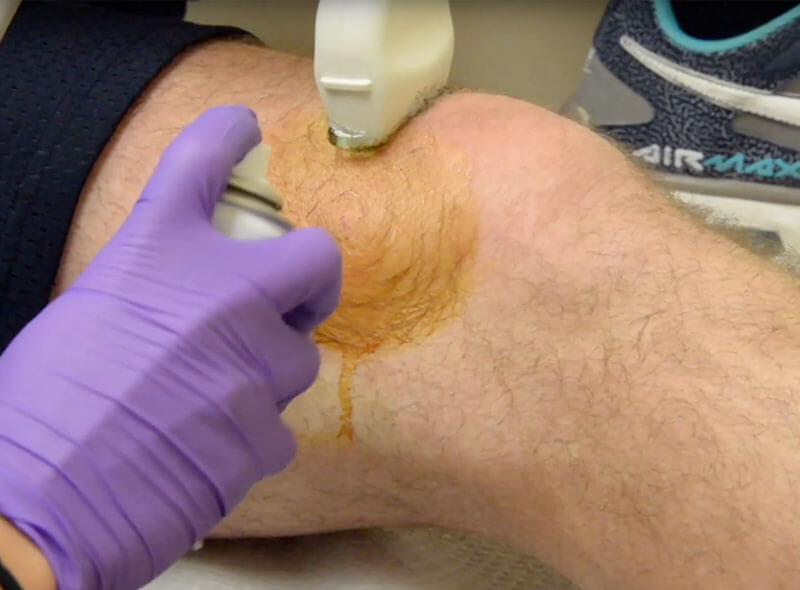 Watch this video to learn what to expect when getting a tissue and/or cell injection. OrthoIndy uses ultrasound guidance for injections.
Watch this video to learn what to expect when getting a tissue and/or cell injection. OrthoIndy uses ultrasound guidance for injections.
5 What is the cost of treatment?
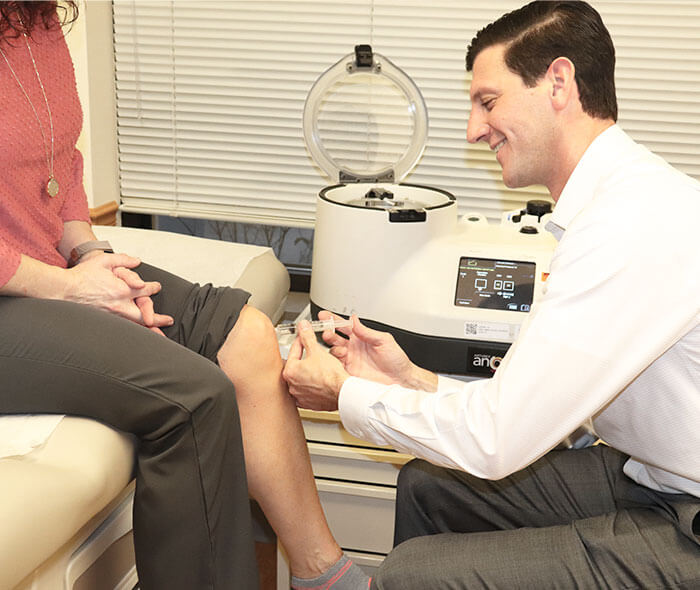
WHAT IS THE COST OF A PRP INJECTION OR ORTHOBIOLOGIC THERAPY?
OrthoIndy offers a number of options for PRP injections and orthobiologic therapies. See the price for each treatment option.
Orthobiologics are natural tissue-derived products that orthopedic surgeons use that on orthopedic injuries and conditions. Orthobiologic therapies may help decrease pain, restore function and may help avoid or delay major surgery, like joint replacement surgery.
When non-surgical treatment options like physical therapy, medication, bracing or cortisone injections have failed, OrthoIndy may prescribe platelet-rich plasma (PRP) injections or tissue therapies.
Unfortunately, these orthobiologic treatments are not currently covered by insurance. Most insurance programs, Medicare and Medicaid label PRP injections and orthobiologic therapies as “experimental or investigational” and do not pay for these treatments.
You will be required to pay for your injection at the time of your treatment.
Consult with your Health Savings Account (HSA) adviser prior to your appointment, as prescribed medical treatments may be allowed for payments from your HSA account.
OrthoIndy uses the following types of PRP and tissue injections. Depending on which one is used in your treatment, the pricing is indicated below, subject to change.
If you are looking to avoid joint replacement surgery, the cost of a platelet-rich plasma injection or other orthobiologic injections is a much cheaper option. However, depending on your condition, a total joint replacement might be necessary. Learn more about the price difference between orthobiologic injections and joint replacement surgery.
For more information about total joint replacement surgery
How much does a total joint replacement cost?
If total joint replacement surgery is necessary, paying for these new medical expenses can be worrisome. First, it’s important to check with your insurance provider to ensure OrthoIndy is in your network. OrthoIndy and OrthoIndy Hospital participates in most major insurance networks.
Many insurance companies have pricing tools that take into account your benefit plan. Visit your insurance provider’s website to see if this is available to calculate surgery costs.
6 Orthobiologics Resources
Our team of experienced physicians has helped thousands of people suffering from joint pain regain mobility and get back to living active lives. Orthobiologics provide cutting-edge treatments that may help restore function and potentially help avoid or delay major surgery. Make an appointment and let OrthoIndy’s team of experts help you get normal back, whatever your normal looks like.
Guides
- A Guide to Tissue and Cell Therapies
- Cost of Orthobiologics
- OrthoIndy OrthoBiologics Program vs. Stem Cell Clinics
Blogs
- Understanding orthobiologics in orthopedic treatment
- Can PRP injections decrease your knee pain?
- Mesenchymal Stem Cells: Time to Change the Name!
Videos


